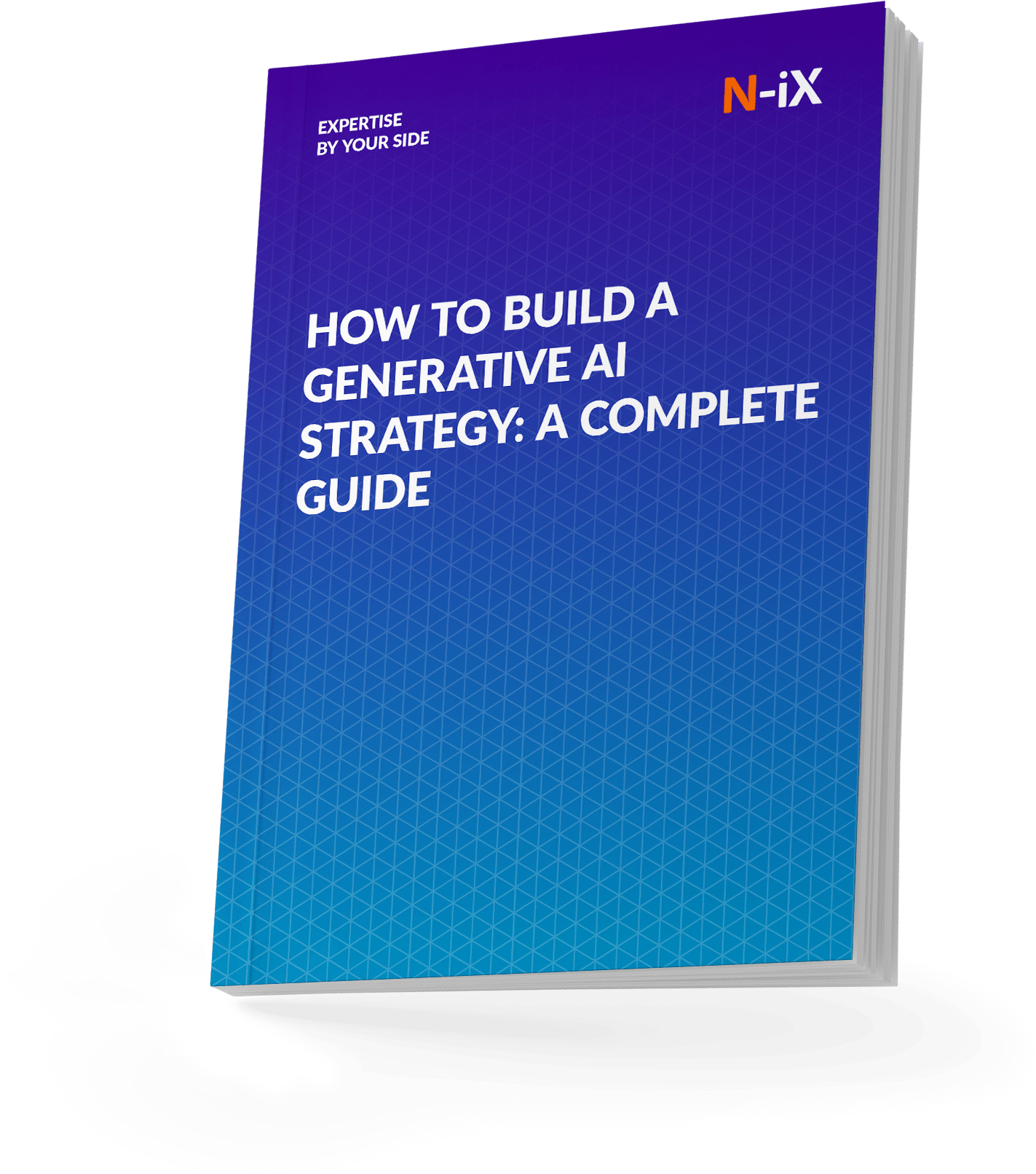In the insurance industry, time and accuracy are everything. Yet, insurers face increasingly complex challenges-rising fraud, more sophisticated risks, and growing customer demand for fast, personalized services. A study found that 57% of insurance executives believe their existing processes are too slow to keep up with the pace of the modern market. In comparison, over 40% reported struggling with detecting emerging risks and fraud effectively [1].
Traditional approaches-manual underwriting, rule-based risk models, or static policy offerings-aren't enough to keep pace. Against this backdrop, established insurers must find ways to modernize legacy systems, introduce more agile operating models, and optimize cost structures-all while maintaining regulatory compliance and managing risk effectively.
And that is where generative AI consulting steps in. Generative AI can filter through large volumes of structured and unstructured data-think historical claims, social media, and sensor data-to generate new insights that were previously hidden. For insurers, this means rethinking everything from underwriting to claims management. Let's explore how generative AI impacts these core insurance processes by use cases and the major implementation risks.
Generative AI in insurance: Outlook
According to a study by EY, nearly all insurers either invest in generative AI or plan to do so, underscoring the technology's growing importance. Specifically, 42% of insurers already invest in generative AI solutions, while 57% have defined strategies to integrate these technologies into their operations soon [2]. But why is generative AI gaining traction in insurance? Major insurers have already seen a 20% to 30% boost in administrative task efficiency, particularly in claims processing and underwriting [3].

These gains are largely attributed to the automation of repetitive and low-value tasks, enabling insurance professionals to focus on higher-level responsibilities like handling complex claims or enhancing customer relationships. Here are some critical questions that insurance leaders should consider when exploring generative AI's potential:
- What specific business problems are you aiming to solve with generative AI?
- How can generative AI help insurers enhance risk modeling and underwriting accuracy?
- What role can generative AI play in reducing fraud and operational inefficiencies in claims processing?
- Can generative AI enable more personalized and responsive customer experiences? If so, how?
- What regulatory challenges might generative AI introduce, and how should they be addressed?
- Is your current data infrastructure equipped to support AI-driven transformations?
Understanding these core aspects is essential for any insurance executive considering generative AI adoption.
Applications of generative AI in insurance industry
To deeply understand the impact of generative AI, we will explore its applications within distinct areas of the insurance industry: Property and Casualty, Life and Annuity, and Group insurance. By breaking down the generative AI use cases in insurance into segments, we better understand how AI addresses specific needs and drives value in each context.

Property and casualty insurance
The Property and Casualty (P&C) insurance sector has experienced transformative changes through generative AI, reshaping how insurers assess risk, detect fraud, and process claims. Insurers increasingly utilize predictive analysis and scenario modeling to evaluate risk and improve decision-making. Insurers can use AI-driven models to forecast natural disasters, weather changes, and other external risks that could affect policyholders. Here are some key questions AI helps answer in P&C insurance:
- How can we better anticipate risks that affect policyholders?
- What proactive measures can we take to mitigate potential financial losses?
- How can we improve premium pricing accuracy based on real-time risk analysis?
Fraud detection and prevention are crucial in P&C insurance, and generative AI plays a significant role here. Based on AI patterns and behavioral models, insurers can detect anomalies that signal fraud much earlier. This proactive detection implies that claims are processed quickly for genuine customers while avoiding unnecessary payouts. This dual benefit from generative AI in insurance saves money and creates a more seamless claims experience. Some of the questions addressed by implementation include:
- How can we identify fraudulent activity earlier in the claims process?
- What behavioral patterns might indicate potential fraud?
- How can we expedite genuine claims while preventing fraud effectively?
Another significant advantage of generative AI in P&C insurance is efficient claims processing. AI can automate claims assessment through intelligent document management and analysis. It can extract and interpret information from images, videos, or documents, significantly reducing the time and effort required to process claims. For example, in the case of a car accident, AI can analyze damage images and provide a cost estimate almost instantly. Important questions addressed by generative AI in insurance include:
- How can we automate the claims assessment process?
- What types of documents and media can AI analyze to improve claims processing?
- How can we enhance response times to customers and reduce administrative overhead?
Life and annuity insurance
In Life and Annuity insurance, generative AI provides tools that make underwriting more precise and customer-centric. This sector focuses on providing coverage that ensures financial security for individuals and families over the long term, making the accuracy and personalization of underwriting crucial.
Automated underwriting assesses data in real time, which allows insurers to offer coverage without excessive paperwork and lengthy manual processes. Generative AI in life insurance examines customer profiles and medical histories, ensuring risk is evaluated more effectively, and policies are priced accordingly. This level of automation enables insurers to provide tailored solutions that cater to individual needs quickly. Here are some key questions AI helps answer in Life and Annuity insurance:
- How can we streamline the underwriting process while ensuring accuracy?
- What customer data is most valuable for risk assessment?
- How can we personalize policies based on individual profiles and needs?
Customer profiling and segmentation are key strengths in this segment, driven by AI's ability to analyze massive volumes of data. Advanced technologies help insurers understand customers more deeply-analyzing their lifestyle, financial status, and changing needs. Key questions addressed by AI include:
- How can we better understand customer needs and preferences?
- What data points are most effective for segmenting customers?
- How can we use profiling to improve customer engagement and retention?
Generative AI enhances scenario modeling, allowing for complex simulations that forecast different life events and enable customers to make informed policy decisions. Predictive analysis helps insurers provide the right product at the right stage of a customer's life, adding value and creating more long-term relationships. Important questions AI helps answer include:
- How can we use scenario modeling to offer more relevant policy options?
- What life events should we consider when tailoring our products?
- How can predictive analysis support better decision-making for customers?
Group insurance
The group insurance sector focuses on providing insurance coverage to groups, such as employees of a company or members of an association, making efficient management and personalization critical for meeting diverse needs. Generative AI can be used for quote and policy generation, especially when dealing with many participants under a group scheme. AI algorithms can analyze group data to quickly generate relevant policies that meet the needs of all members, significantly reducing administrative complexities and speeding up policy issuance. Here are some questions AI helps answer in group insurance:
- How can we efficiently generate quotes and policies for large groups?
- What group-specific data is crucial for policy customization?
- How can we reduce administrative burdens while maintaining accuracy?
Advanced risk assessment is another critical area where AI is invaluable. Insurers can evaluate collective risk profiles for a group, such as employees in a company, based on demographic data and behavioral patterns. Generative AI in insurance industry allows for tailored premiums and better risk management across the entire group. It also means that risk is distributed more accurately, resulting in fairer premiums for all involved. Key questions addressed:
- How can we assess group risk profiles more accurately?
- What demographic data is most relevant for group insurance policies?
- How can we ensure fair premium distribution across all members?
Fraud detection in group insurance is also made more efficient through generative AI, which can spot patterns typically overlooked by human analysis, such as multiple claims from the same group under suspicious conditions. AI models continually learn from data, allowing insurers to avoid potential fraudulent activities. Key questions AI helps answer include:
- How can we detect fraudulent claims within group policies more effectively?
- What patterns should we monitor to identify potential fraud?
Cross-segment applications
Generative AI offers innovative capabilities for specific insurance segments, enabling industry-wide improvements. Below are several cross-segment generative AI use cases in insurance that highlight how generative AI can enhance the entire insurance value chain:
- Customer support and virtual assistants: AI-powered virtual assistants and chatbots efficiently handle customer inquiries, guide policyholders through processes, and provide a consistent, high-quality experience.
- Personalized insurance products: Generative AI in insurance can create customized insurance products that meet each client's needs based on customer data. This capability allows insurers to move away from generalized, one-size-fits-all offerings towards more customized policies that provide real value based on individual preferences, financial circumstances, and risk profiles.
- Document management: Efficient document management is essential for insurers, and AI significantly streamlines this area. Generative AI tools can automatically extract information from various documents, categorize files, and store them, leading to less paperwork and quicker access to critical information.
By applying these AI-driven solutions across all insurance industry segments, companies can create a cohesive and advanced infrastructure that drives value, enhances efficiency, and ultimately offers a better customer experience.
Read more about current use cases of conversational AI in insurance
Why hasn't every insurer implemented generative AI yet?
Insurers face multiple challenges that can impede successful implementation, ranging from bias in decision-making models to regulatory compliance, data security, and integration hurdles. Here, we outline the most pressing challenges insurers encounter when adopting generative AI and provide strategic solutions from N-iX to help overcome these barriers.
Unreliable model training
Inaccurate or insufficient model training is a common concern in deploying generative AI. Generative models trained on limited, unstructured, or biased datasets can produce erroneous outputs-known as AI hallucinations-that compromise decision-making. As a result, unreliable model training remains a persistent barrier to achieving high performance and operational accuracy.
Our solution: N-iX mitigates this risk by implementing rigorous data preparation and quality control protocols. Models are trained on diverse, high-quality datasets to reduce biases and improve accuracy. Our team uses advanced Machine Learning methodologies, including transfer learning and domain-specific training, to refine models for insurance-specific scenarios.
Regulatory ambiguity and ethical considerations
Navigating complex and evolving regulations is a major challenge for insurers looking to deploy generative AI. Two-thirds of surveyed insurers cited unclear regulations as a primary barrier to establishing AI initiatives, with this concern being particularly acute in the life and annuity segments (89% of respondents), compared to 39% in the P&C sector [2].
Our solution: We build AI governance frameworks that comply with local and international regulatory standards. We integrate compliance-by-design principles into every AI project, ensuring that models are effective and fully auditable.
Integration with legacy IT systems
Legacy IT infrastructure remains a significant barrier to AI adoption, particularly for organizations reliant on fragmented data environments. Over 54% of insurers cite integration costs as an important hurdle, while 46% are concerned about the technical complexities of integrating AI models into aging systems [2]. These issues can slow down implementation and increase operational costs.
Our solution: N-iX offers end-to-end integration services that connect generative AI models to existing IT ecosystems without disrupting business operations. We leverage microservices architecture, APIs, and middleware solutions to achieve seamless integration. Our approach includes phased modernization strategies, enabling insurers to transition to AI-enabled systems while gradually maintaining service continuity.
Unclear ROI models and measurement of success
A lack of clear return on investment models makes it challenging to justify large-scale investments in generative AI. Many insurers face difficulty defining ROI for AI projects, particularly regarding metrics like underwriting precision and pricing accuracy. Like all the businesses for insurance it can lead to stalled AI initiatives or a reluctance to scale existing projects.
Our solution: N-iX works closely with insurers to build detailed business cases for generative AI in insurance deployments. We establish clear KPIs for each project, focusing on tangible outcomes such as reduced claims processing time, increased underwriting accuracy, and improved customer satisfaction.
The success story of implementing generative AI: N-iX enhanced the user experience for a global peer-to-peer review platform. We implemented a Pros and Cons feature powered by GPT-4 and Machine Learning. This feature helped streamline user feedback into easily digestible summaries, improving the platform's SEO and attracting more traffic. Additionally, optimizations in the NLP model and cost-effective use of OpenAI API led to a notable reduction in operating expenses for the client, demonstrating clear ROI from the AI initiative. Check out more information on generative AI as a solution here.
Build an effective Generative AI strategy for your business – get the step-by-step guide!


Success!

Bottom line
When a new technology like generative AI comes along, there is often a rush to experiment without a clear strategy, leading to fragmented efforts that fail to deliver meaningful outcomes. Organizations need a structured approach that involves strategic planning, cross-functional collaboration, and external partnerships to leverage generative AI effectively. Insurers need access to curated, high-quality data and robust AI governance to align AI-driven initiatives with enterprise goals.
N-iX is a reliable partner for implementing generative AI in the insurance industry due to our extensive experience and proven track record. Here are some reasons why:
- N-iX has over 23 years of experience in the technology industry.
- Our team of over 200 data, AI, and ML experts are well-versed in the latest AI technologies and methodologies. We have delivered over 60 data science and AI projects, making us a reliable partner for your generative AI needs.
- We adhere to the latest security standards and market regulations, ensuring our solutions are secure and compliant.
- N-iX has been named a Rising Star of ISG Provider Lens™ Public Cloud Services and Solutions for the UK market.
- N-iX offers end-to-end services, from business concept validation to implementing a critical business module with a real team.
- We have a proven track record of successful collaborations with Fortune 500 companies such as Lebara, a renowned telecom company, and Gogo, a leading provider of in-flight connectivity.
For insurers that are hesitant to embrace generative AI, the risks of inaction are growing. The longer traditional insurers delay, the wider the gap becomes, making it increasingly difficult to catch up.
Embrace the future of insurance-partner with N-iX for a smarter, more agile tomorrow.
Reference
- Navigating the insurance sector through a fraud risk lens - Delloite
- Generative AI in insurance - EY Parthenon
- The Future of Insurance Claims - BCG
- Generative AI in the insurance industry - Sprout.AI
- State of AI Bias - DataRobot
Have a question?
Speak to an expert




